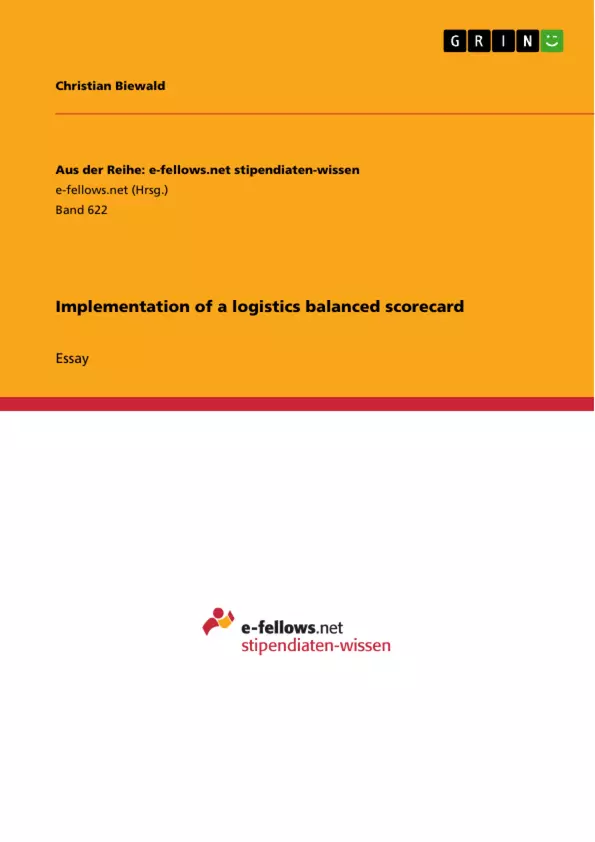In future industry competition will be increasingly “supply chain vs. supply chain”, rather than “firm vs. firm”. So today, the efficient management of global supply chain networks already has the potential to create competitive advantages for companies. Nevertheless most industrial companies still focus on production efficiency, creating non-market oriented business solutions that disable fast adaption to changing customer requirements. In more and more saturated markets a technology-driven competitive advantage is often quickly compensated by low-cost countries. In contrast high service quality established by efficient logistics processes can hardly be adopted in short time. The ability of fast consumer response allows companies to create an added value the customer is willing to pay for. But empowering companies to offer this added value requires high management attention on logistics processes as well as a clear logistics strategy with defined objectives that meet the company’s abilities and the customer requirements.
Several management tools like the Supply Chain Operations Reference (SCOR) model or the Balanced Scorecard provide a structured approach to realize competitive advantages in the management of supply chains. After a short theoretical survey of these tools, a suitable logistics balanced scorecard will be developed for the supply chain activities of Diehl Controls, an electronics manufacturer for home appliances. Based on the company’s logistics mission and vision statement, internal and external strategic objectives will be determined. In a further step, the controlling of these objectives will be ensured by creating suitable performance indicators. Finally the Diehl Controls logistics balanced scorecard will be introduced to the company’s organization. The term paper ends with a recommendation of future developments and enlargements of the balanced scorecard related to the company’s growth within the next years.
Table of Contents
- Abstract
- Brief description of term paper intention
- Purpose of the term paper
- Supply Chain Performance Measurement concepts
- SCOR model
- Balanced scorecard
- Company presentation
- Diehl Controls Logistics Balanced Scorecard
- Logistics scope
- Mission and vision statement
- Strategic objectives and KPIs
- Recommendation
Objectives and Key Themes
The term paper aims to develop a logistics balanced scorecard for the internal logistics department of Diehl Controls, an electronics manufacturer for home appliances. The paper begins by outlining the theoretical concepts behind supply chain performance measurement using the SCOR model and balanced scorecard frameworks. It then applies these frameworks to Diehl Controls, defining the company's logistics mission and vision statement, identifying strategic objectives and KPIs, and creating a performance measurement system. Finally, the paper concludes with recommendations for future development and expansion of the balanced scorecard.
- Supply Chain Performance Measurement
- SCOR model
- Balanced Scorecard Framework
- Logistics Strategy Development
- Performance Measurement and KPI Development
Chapter Summaries
- Chapter 1: Introduces the concept of supply chain competition and highlights the importance of efficient logistics management for creating a competitive advantage. It explains the purpose of the term paper, which is to develop a logistics balanced scorecard for Diehl Controls.
- Chapter 2: Discusses two key frameworks for supply chain performance measurement: the SCOR model and the balanced scorecard. It explains the theoretical concepts behind each framework and their importance in achieving supply chain efficiency.
- Chapter 3: Provides an overview of Diehl Controls, a company that manufactures electronics for home appliances. This chapter serves as a foundation for the development of a logistics balanced scorecard tailored to the specific needs of the company.
- Chapter 4: Focuses on the development of the Diehl Controls logistics balanced scorecard. It outlines the company's logistics scope, mission and vision statement, and defines strategic objectives and key performance indicators (KPIs) aligned with those objectives. The chapter also presents a dashboard for monitoring these KPIs.
Keywords
The main keywords and focus topics of this text are: supply chain management, performance measurement, SCOR model, balanced scorecard, logistics strategy, KPIs, Diehl Controls.
- Quote paper
- Dipl.-Wirtsch.-Ing. Christian Biewald (Author), 2013, Implementation of a logistics balanced scorecard, Munich, GRIN Verlag, https://www.grin.com/document/208403



